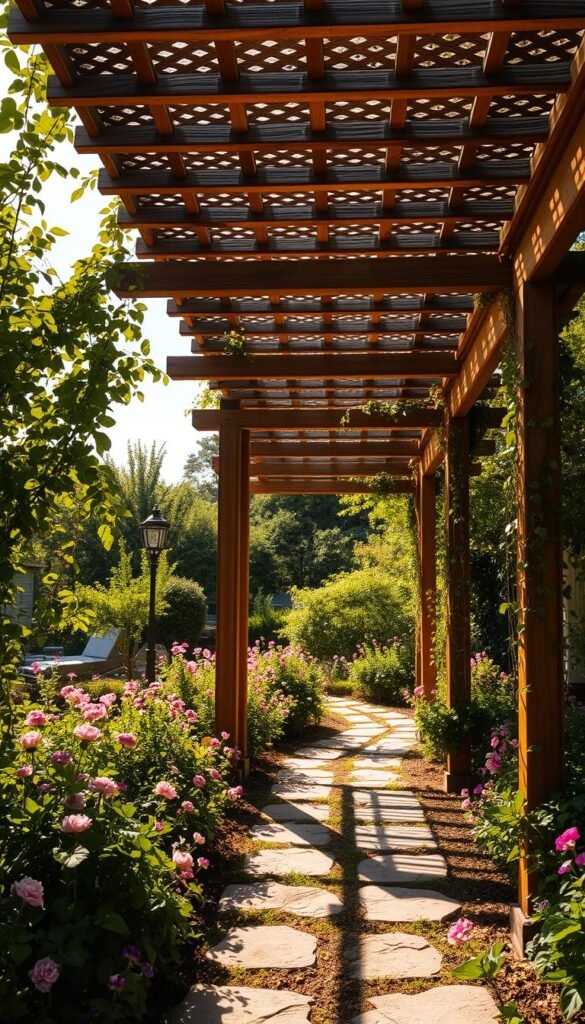Imagine stepping into your backyard and finding a cozy retreat that blends beauty with practicality. A well-designed pergola creates focal points while offering relief from the sun’s glare. These structures turn ordinary yards into inviting extensions of your home, perfect for relaxation or entertaining guests.
Beyond aesthetics, they serve a purpose. Open-roof designs let sunlight filter through during cooler months, while adjustable covers provide customizable shade when temperatures rise. Pair them with climbing vines or string lights to craft an atmosphere that reflects your personal style.
You’ll find endless ways to adapt these features to your needs. From defining dining areas to framing flower beds, they add architectural depth without overwhelming your landscape. Durable materials like cedar or vinyl ensure longevity, making them smart investments for boosting property appeal.
This guide walks through creative approaches to maximize both form and function. Discover how to balance privacy, airflow, and visual harmony—all while creating a sanctuary you’ll love using year-round.
Introduction: Crafting Your Dream Outdoor Oasis
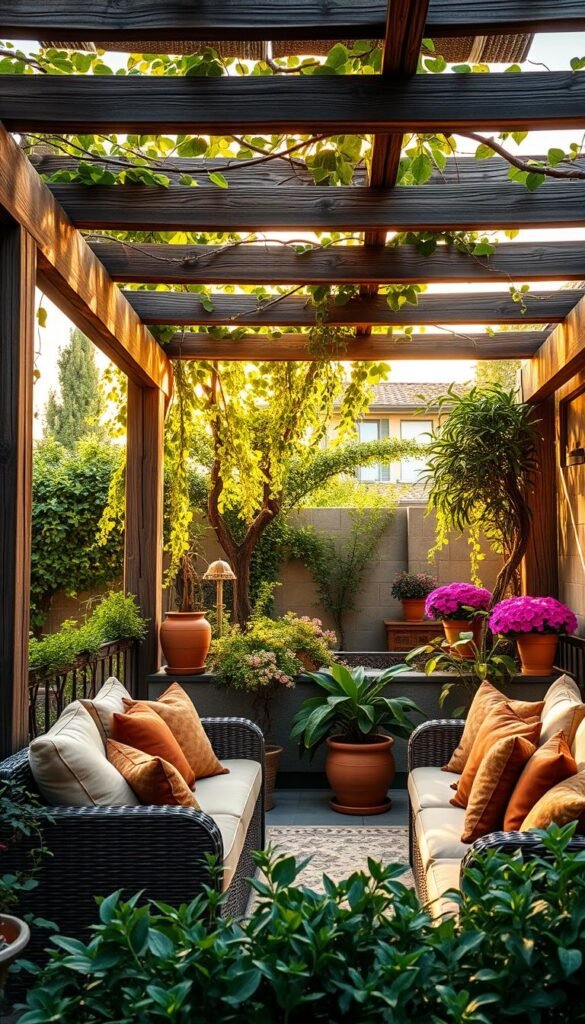
Picture a space where morning coffee and evening gatherings feel wrapped in natural charm. Your backyard can evolve into a sanctuary that balances relaxation with style. With smart design choices, you’ll craft an outdoor living area that invites connection and calm.
Wooden structures draped in flowering vines like wisteria create instant beauty. These living canopies soften sunlight while adding texture to your space. Imagine fragrant blossoms framing your view as you unwind beneath their shade.
Versatile layouts let you define areas without walls. Try these elements to maximize functionality:
| Element | Purpose | Example |
|---|---|---|
| Open Lattice | Filters sunlight | Climbing roses |
| Adjustable Canopy | Controls shade levels | Retractable fabric |
| Integrated Lighting | Extends evening use | Weatherproof LEDs |
Your oasis grows with you. Add curtains for privacy during family dinners or remove panels for stargazing nights. This adaptability makes your investment timeless.
Understanding Pergolas: Form, Function, and Flair
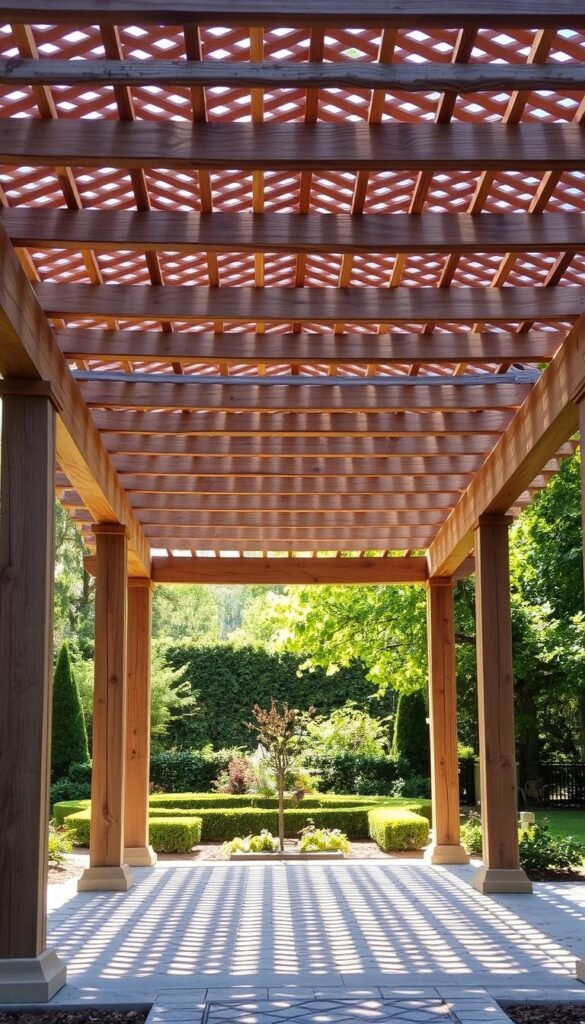
Let’s break down why these structures have become backyard essentials. Unlike solid-roofed gazebos or standalone arbors, they strike a balance between airy design and purposeful shade.
What Exactly Is a Pergola?
At its core, it’s a framework of vertical posts and horizontal crossbeams. The signature open lattice roof filters sunlight instead of blocking it completely. This design invites climbing plants to weave through gaps, creating natural canopies over time.
Benefits of Structure and Shade
Beyond beauty, these features provide shade that adapts to your needs. Vines like jasmine or clematis grow across beams, offering seasonal coverage. You’ll enjoy cooler spots in summer while maintaining airflow—a perk solid roofs can’t match.
| Feature | Pergola Advantage | Gazebo/Arbor Difference |
|---|---|---|
| Roof Type | Adjustable (open or covered) | Fixed solid roof |
| Plant Support | Built for climbing greenery | Limited integration |
| Space Feel | Open, airy | Enclosed, shaded |
Use them to frame dining areas or guide footpaths. Their versatility lets you shape outdoor zones that feel intentional yet relaxed. Plus, they add vertical interest without shrinking your yard visually.
10 Garden Pergola Ideas to Add Structure and Shade
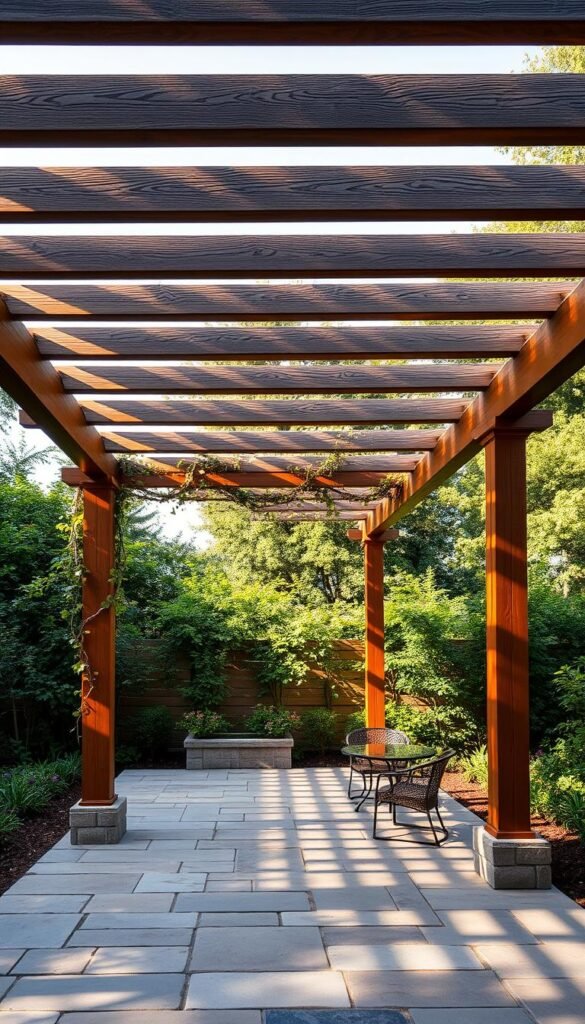
Transform your yard into a curated escape with structures that marry form and purpose. These frameworks adapt to any setting—whether you’re working with a snug balcony or sprawling lawns. Their magic lies in how they redefine areas while maintaining an open, airy feel.
Consider a minimalist design with clean lines for modern patios. Pair it with sheer curtains that flutter in the breeze, offering just enough privacy without blocking sunlight. Or, go rustic with reclaimed wood beams supporting cascading grapevines—nature’s own sunblock.
Urban dwellers often lean toward vertical gardens integrated into their setups. Imagine fragrant jasmine weaving through overhead slats, creating a living ceiling. For larger properties, extend the structure to frame a lounging zone, complete with weather-resistant sofas and pendant lights.
“A well-placed pergola acts like punctuation in your landscape—it gives rhythm to the space,” notes a California-based designer.
Not just for looks, these features solve practical challenges. Use them to shield a hot tub from prying eyes or to anchor a hammock between posts. The right materials and plants ensure your setup evolves with the seasons, staying relevant year after year.
Selecting the Perfect Pergola Material
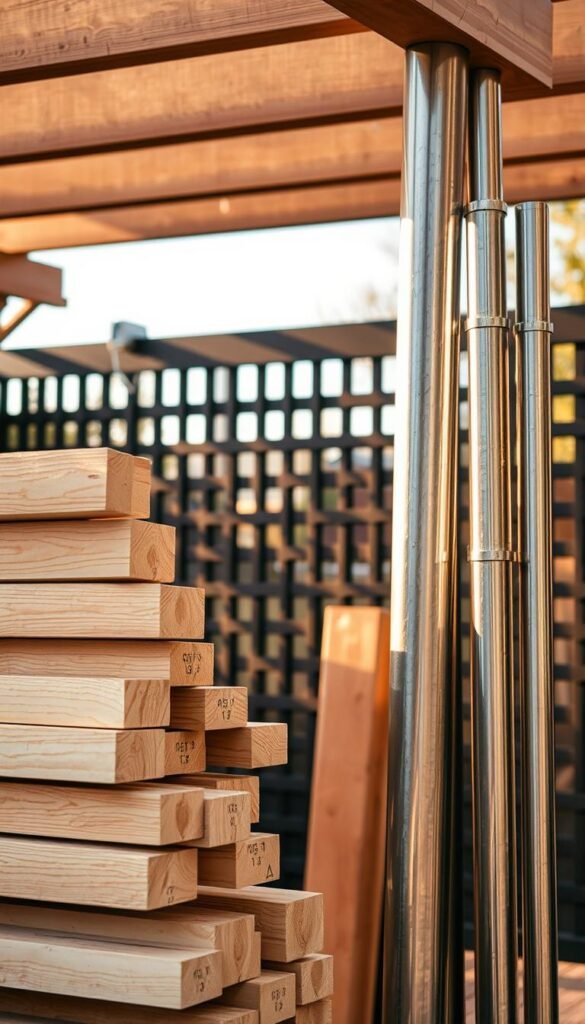
Choosing materials for your backyard centerpiece shapes its durability, style, and how much time you’ll spend maintaining it. Whether you prioritize rustic charm or modern simplicity, each option brings unique strengths. Let’s explore what works best for different climates and lifestyles.
Wood, Metal, and Vinyl Options
Wood remains a classic choice, especially cedar or redwood. These varieties resist rot naturally and blend seamlessly with gardens. However, they require annual sealing to prevent weathering. For a sleek look, aluminum or steel frames offer low maintenance and withstand harsh sun or rain.
Vinyl stands out for its hassle-free care—no staining needed. While it lacks the warmth of natural wood, it comes in various colors to match your home’s exterior. Consider your local weather: metal excels in windy areas, while vinyl avoids warping in humidity.
Durability and Maintenance Tips
Your material choice impacts long-term costs. Here’s a quick comparison:
| Material | Best For | Maintenance Level | Lifespan |
|---|---|---|---|
| Wood | Traditional styles | Moderate | 10-15 years |
| Metal | Modern designs | Low | 20+ years |
| Vinyl | Coastal climates | Minimal | 15-25 years |
To boost appeal, pair materials with complementary elements. For example, add planter boxes with drought-resistant plants from this patio gardening guide. If you’re unsure about structural needs, pergola design experts can help match materials to your vision.
Designing Your Multi-Functional Outdoor Living Space
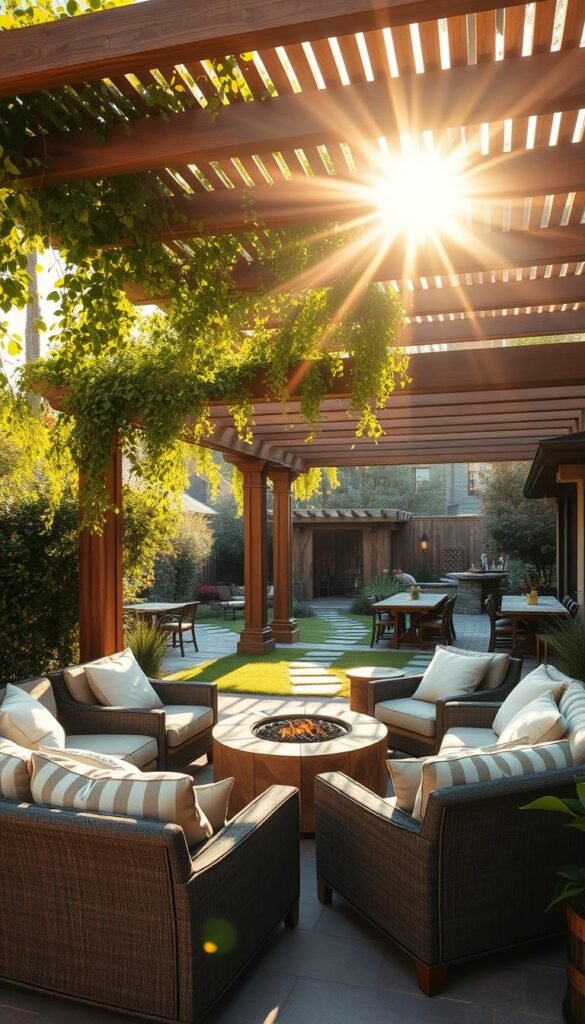
Ever thought your backyard could rival your living room’s comfort? With smart planning, your open-air setup becomes a chameleon—ready for lazy Sundays or lively cookouts. The key lies in blending flexibility with coziness.
Seating That Feels Like a Hug
Start with plush, weather-resistant cushions on deep-seated loungers. Arrange them in U-shapes or circular patterns to spark conversations. Add ottomans that double as side tables—perfect for resting drinks or feet. “Outdoor furniture should invite people to linger,” says a Texas-based landscape architect. “Think sunkissed naps and lemonade chats.”
Dining Areas That Steal the Show
Anchor your dining area with a sturdy table that withstands rain and spills. Bench seating saves space while encouraging casual meals. String Edison bulbs overhead for evening ambiance—their warm glow turns Tuesday tacos into memorable events.
Consider these elements for zone definition:
| Element | Purpose | Example |
|---|---|---|
| Area Rugs | Marks seating zones | UV-resistant jute |
| Planters | Softens edges | Potted lavender |
| Privacy Screens | Creates intimacy | Bamboo lattices |
For weather protection, install retractable shades matching your gardening aesthetic. Store throw blankets in waterproof deck boxes—they’re lifesavers when autumn chills arrive. Your space now adapts like a stage: morning yoga spot, afternoon office, twilight wine bar—all without missing a beat.
Enhancing Your Backyard with Pergola-Centered Zones
Think of your backyard as a blank canvas waiting for definition. A well-placed pergola acts like invisible walls, carving out spaces for dining, lounging, or quiet reflection. These structures guide movement while letting light and air flow freely—no claustrophobic walls needed.
Start by mapping sunlight patterns. Position seating areas where morning rays warm your coffee spot, while evening zones catch sunset hues. For example, place a vine-covered frame near existing trees to blend shade with natural beauty. This creates microclimates tailored to different activities.
Here’s how to maximize impact:
| Zone Purpose | Placement Tip | Ideal Features |
|---|---|---|
| Dining | Near kitchen access | Overhead string lights |
| Relaxation | Partial shade post-noon | Hanging swing bench |
| Pathway | Connects key areas | Climbing jasmine |
Blend your structure with existing elements. Curve a pergola around mature flower beds or angle it to frame a water feature. This design trick makes additions feel intentional, not forced. For inspiration, explore pergola zoning ideas that balance form and flow.
Even compact yards benefit. A narrow frame over a bistro set defines an intimate nook without crowding. Add floating shelves for herbs or trailing plants to soften edges. Your space gains purpose without sacrificing openness.
Open Lattice Designs and Climbing Plant Accents
There’s magic in watching nature and architecture collaborate. An open lattice pergola becomes a living sculpture when paired with climbing plants. Their tendrils dance across beams, weaving seasonal tapestries of color and texture overhead.
Showcasing Vines, Wisteria, and Bougainvillea
Bougainvillea bursts into vibrant paper-like blooms, thriving in sunny climates. Its thorny stems need sturdy metal frames—perfect for Southwestern backyards. Wisteria’s lavender clusters create dreamy canopies but demand vigilant pruning. Wooden structures may buckle under its enthusiastic growth.
Consider these pairings for success:
| Plant | Best Material | Growth Speed | Maintenance Tip |
|---|---|---|---|
| Bougainvillea | Metal | Fast | Trim after flowering |
| Wisteria | Steel | Aggressive | Prune twice yearly |
| Clematis | Wood/Vinyl | Moderate | Mulch roots |
Train vines early using soft ties. Guide them through lattice gaps to prevent overcrowding. In coastal areas, salt-tolerant jasmine adds fragrance without overwhelming structures. Remember: match plant vigor to your willingness to prune!
Cool-climate gardeners can opt for climbing hydrangeas. Their slower growth suits wooden frames, creating dappled shade within three seasons. Pair with shade-loving ferns below for layered beauty.
Utilizing Pergolas to Define Outdoor Pathways
Turn basic walkways into captivating journeys with strategic pergola placement. These structures act as elegant guides, leading eyes and feet through your landscape while adding depth. Imagine strolling beneath a leafy tunnel that transitions from vegetable plots to rose beds—every step feels intentional.
An arched design over a gravel path creates anticipation. Vines like trumpet creepers cascade from beams, offering dappled shade in summer. For narrow spaces, pair low-profile frames with vertical planters to maintain openness without sacrificing definition.
Key considerations for pathway designs:
| Design Style | Best Use | Plant Pairing |
|---|---|---|
| Garden Tunnel | Long walkways | Wisteria, grapes |
| Arched Entryway | Zone transitions | Climbing roses |
| Modular Frames | Curved paths | Morning glories |
Keep proportions balanced. A 7-foot height works for most residential paths, allowing clearance while feeling intimate. “Pathway pergolas should whisper direction, not shout commands,” advises a Colorado landscaper. Use materials matching nearby structures—wood for cottage gardens, powder-coated metal for modern settings.
In smaller yards, position a single arch where paths split. It becomes a decision point: left toward the fire pit, right to the herb spiral. This smart framing makes compact areas feel thoughtfully organized rather than cramped.
Transforming Spaces: From Patio Pub to Fireside Nook
Your backyard isn’t just for barbecues—it’s a blank slate for imaginative escapes. Picture a patio pub crowned by a wooden frame draped in solar string lights. Add a bricked-in countertop beneath for mixing drinks, and suddenly, your evening hangouts rival downtown hotspots.
Adding a Touch of Whimsy with Swings
Who says swings belong only on playgrounds? Hang a cushioned bench from sturdy beams to create a breezy reading nook. Local contractors can craft custom designs, or grab a DIY kit for weekend projects. Pair with wind chimes for melodic charm that turns heads.
Innovative Uses for Outdoor Kitchens
Elevate your outdoor dining game by framing grilling stations with pergolas. The overhead structure shades sizzling pans while housing pendant lights for late-night flip sessions. “Blend function with fun,” suggests a Florida designer. “A well-placed frame turns meal prep into theater.”
| Feature | DIY Option | Contractor-Built |
|---|---|---|
| Cost | $200-$600 | $1,500+ |
| Install Time | 4-8 hours | 2-5 days |
| Customization | Limited | Full design control |
For cooler nights, position a fire pit under an open-roof design. The structure contains warmth while letting smoke escape—no more teary eyes during marshmallow roasts. Complement the vibe with fairy lights woven through beams, casting starry patterns on your new retreat.
Creating a Cozy Outdoor Dining Room Under a Pergola
Your evening meals deserve more than a picnic table under the stars. Position your outdoor dining setup just steps from the back door, where pergola beams filter harsh sunlight while letting breezes swirl freely. This setup turns weeknight dinners into sensory experiences—think clinking glasses under twinkling lights as dusk settles.
Setting Up Ambient Lighting and Décor
Start with weatherproof furniture that invites lingering. A rectangular teak table seats eight comfortably, while stackable chairs simplify cleanup. Drape sheer curtains on two sides for privacy without blocking views—they’ll dance gently in summer winds.
Lighting sets the mood. Try these layered options:
| Light Type | Effect | Installation Tip |
|---|---|---|
| Edison Bulbs | Warm, golden glow | String along crossbeams |
| Lanterns | Focused table light | Hang from corner hooks |
| Path Lights | Guides guests safely | Line nearby walkways |
“Light transforms a dining area from functional to magical,” notes a New England designer. Add pops of color with fade-resistant cushions in sunset hues. For cooler evenings, tuck folded throws into a rustic crate beneath the table—both practical and charming.
Switch between casual and formal vibes effortlessly. Use patterned plates and mason jars for brunch, then swap in linen napkins and taper candles for anniversary dinners. Your pergola becomes the ultimate room without walls, adapting to every occasion.
Customizing Your Pergola for Privacy and Comfort
Your outdoor haven becomes truly personal when tailored to your needs. A pergola can balance openness with privacy through smart design tweaks. Add adjustable lattice panels or flowing curtains to control visibility without sacrificing airflow—ideal for intimate dinners or quiet reading corners.
Climbing plants like ivy or honeysuckle soften edges while enhancing seclusion. Their natural growth patterns create living walls that filter sunlight and muffle neighborhood noise. Pair them with hanging planters for vertical layers that refresh the look seasonally.
Strategic placement matters. Angle your structure to block sightlines from nearby windows or busy walkways. Retractable shades offer flexibility, letting you welcome breezes or cocoon in shade. This adaptability keeps your space usable whether you’re hosting friends or savoring solo mornings.
Don’t forget airflow. Position beams to channel cool air during summer while sheltering from harsh winds. With thoughtful touches, your pergola becomes a retreat that mirrors your lifestyle—a place where privacy and comfort coexist effortlessly.
FAQ
What’s the best material for a long-lasting pergola?
Can I grow climbing plants on a vinyl pergola?
How do I add shade to an open-lattice design?
Are pergolas suitable for rainy climates?
Can a pergola work with an outdoor kitchen?
What lighting options enhance a pergola at night?
How do I make my pergola more private?
Can I attach a pergola to my house?
What’s the average cost of a DIY pergola?
FAQ
What’s the best material for a long-lasting pergola?
Cedar and redwood are top choices for natural durability and insect resistance. For low maintenance, vinyl or powder-coated aluminum withstands weather while keeping its look. Metal offers modern flair but may need rust protection. Match your climate and style needs!
Can I grow climbing plants on a vinyl pergola?
Absolutely! Vinyl holds up well against moisture, making it ideal for vines like clematis or jasmine. Use lightweight trellis panels to support growth without stressing the structure. Avoid heavy plants like mature wisteria unless reinforced.
How do I add shade to an open-lattice design?
Retractable fabric canopies or shade sails offer adjustable coverage. For a natural fix, train fast-growing vines like bougainvillea across the beams. Bamboo roll-up blinds also add privacy and block harsh sun.
Are pergolas suitable for rainy climates?
Yes! Opt for materials like treated cedar or metal with a sloped roof. Add polycarbonate panels or waterproof roofing to redirect rain. Ensure proper drainage to prevent pooling and prolong your structure’s life.
Can a pergola work with an outdoor kitchen?
Definitely! Position it to shield your cooking area from direct sun. Use heat-resistant materials like stone or metal near grills. Complement with pendant lights and built-in seating for a functional, inviting space.
What lighting options enhance a pergola at night?
String lights create a cozy glow, while recessed LED spots offer task lighting for dining. Lanterns or solar-powered post lights add charm. For drama, wrap fairy lights around climbing plants or beams.
How do I make my pergola more private?
Hang outdoor curtains for a soft, adjustable screen. Lattice panels with trailing ivy or tall shrubs around the base also block sightlines. For year-round coverage, install decorative privacy screens or bamboo fencing.
Can I attach a pergola to my house?
Yes—attached designs save space and blend indoor-outdoor flow. Ensure proper anchoring to your home’s structure and check local building codes. Use matching materials like brick or siding for a seamless look.
What’s the average cost of a DIY pergola?
Wood kits range from
FAQ
What’s the best material for a long-lasting pergola?
Cedar and redwood are top choices for natural durability and insect resistance. For low maintenance, vinyl or powder-coated aluminum withstands weather while keeping its look. Metal offers modern flair but may need rust protection. Match your climate and style needs!
Can I grow climbing plants on a vinyl pergola?
Absolutely! Vinyl holds up well against moisture, making it ideal for vines like clematis or jasmine. Use lightweight trellis panels to support growth without stressing the structure. Avoid heavy plants like mature wisteria unless reinforced.
How do I add shade to an open-lattice design?
Retractable fabric canopies or shade sails offer adjustable coverage. For a natural fix, train fast-growing vines like bougainvillea across the beams. Bamboo roll-up blinds also add privacy and block harsh sun.
Are pergolas suitable for rainy climates?
Yes! Opt for materials like treated cedar or metal with a sloped roof. Add polycarbonate panels or waterproof roofing to redirect rain. Ensure proper drainage to prevent pooling and prolong your structure’s life.
Can a pergola work with an outdoor kitchen?
Definitely! Position it to shield your cooking area from direct sun. Use heat-resistant materials like stone or metal near grills. Complement with pendant lights and built-in seating for a functional, inviting space.
What lighting options enhance a pergola at night?
String lights create a cozy glow, while recessed LED spots offer task lighting for dining. Lanterns or solar-powered post lights add charm. For drama, wrap fairy lights around climbing plants or beams.
How do I make my pergola more private?
Hang outdoor curtains for a soft, adjustable screen. Lattice panels with trailing ivy or tall shrubs around the base also block sightlines. For year-round coverage, install decorative privacy screens or bamboo fencing.
Can I attach a pergola to my house?
Yes—attached designs save space and blend indoor-outdoor flow. Ensure proper anchoring to your home’s structure and check local building codes. Use matching materials like brick or siding for a seamless look.
What’s the average cost of a DIY pergola?
Wood kits range from $1,500 to $4,000, depending on size and wood type. Vinyl or metal options may cost more upfront but save on maintenance. Custom designs or professional installation increase the budget.
How do I protect my pergola from strong winds?
Secure posts with concrete footings and cross-brace the structure. Avoid solid roofs that catch wind—opt for open designs or flexible shade solutions. Regularly trim nearby trees to reduce debris damage.
,500 to ,000, depending on size and wood type. Vinyl or metal options may cost more upfront but save on maintenance. Custom designs or professional installation increase the budget.
How do I protect my pergola from strong winds?
Secure posts with concrete footings and cross-brace the structure. Avoid solid roofs that catch wind—opt for open designs or flexible shade solutions. Regularly trim nearby trees to reduce debris damage.

